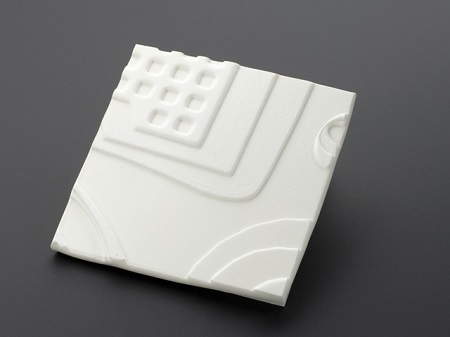
Facial reconstruction methods are often needed to treat bone gaps that result from birth defects and injuries. At Texas A&M, researchers have developed a shape-memory polymer that has the potential to fill in critical-sized bone defects in the face, as well as allow for the growth of new bone cells.
Biodegradable Shape-Memory Polymer
The research team’s “self-fitting” material is a biodegradable shape-memory polymer (SMP), a type of material that becomes malleable when heated to a specific temperature. When heated, the polymer can transmute from a rigid state to become extremely pliable, allowing for it to be easily molded. With its physical properties, the SMP could be used to fill in bone defects in the head, face, or jaw.
The research team, spearheaded by Melissa Grunlan, Ph.D., presented their work at the 248th National Meeting & Exposition of the American Chemical Society (ACS) last month.

Sample of a shape-memory polymer foam used for research on shape-memory airplanes. Image By Science Museum London / Science and Society Picture Library CC-BY-SA-2.0, via Wikimedia Commons.
How Does It Work?
The Texas A&M team engineered their SMP by combining molecules of a biodegradable and elastic substance called poly(ε-caprolactone). This combination resulted in a material that appears to look and feel like a hard sponge, as it contains many pores.
During a procedure, a surgeon can heat up the material until it becomes malleable, mold it, and proceed to fill in the area where the bone defect exists. The SMP will recover its initial hardness and lock into place when cooled at body temperature.

Schematic of the shape-memory effect.
What makes the research team’s material so special is that it possesses porous properties that makes it act similar to a scaffold, allowing for new bone cells to migrate and grow within its pores. Because the material is biodegradable, the scaffold will eventually disappear over time, leaving only new bone behind.
Advantages Over Current Methods
Grunlan’s research team was tasked with developing a material that both remained stiff after cooling and promoted new bone cell growth — two traits that do not seem to exist with current reconstruction procedures.
A more common procedure used today is autografting, which involves extracting bone from one area of the body and molding it in such a way to fit the bone defect. Using a patient’s own bone tissue (the autograft), however, creates yet another surgery the patient needs to recover from, which means additional discomfort and a more extensive stay in the hospital.
An alternate procedure involves the use of bone putty or cement to fill in bone gaps. However, these materials tend to become fragile when hardened. Additionally, these same materials do not promote the growth of new bone cells because they lack holes or pores. Meanwhile, the Texas A&M researchers claim their SMP does not become brittle when hardened and allows for new bone cell growth, thanks to its porous properties.



Comments (1)
Said M.
March 25, 2022Hello,
How I can model shape memory polymers by COMSOL?